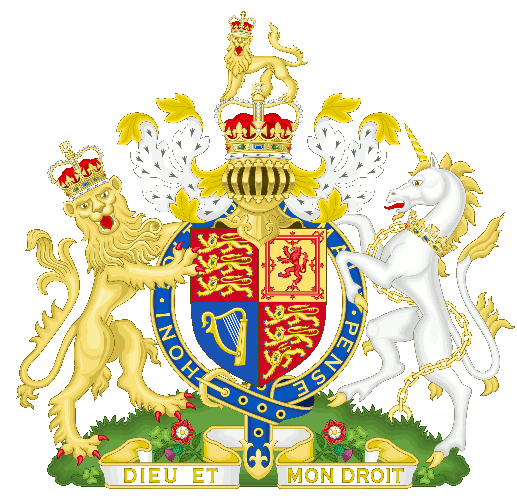
by John P. Pratt
6 Feb 2021, 1 Aquarius (S), 1 Sagittarius (US)
©2021 by John P. Pratt. All rights Reserved.
|
1. Tribe Membership 1.1 Paternal Line 1.2 Adoption 2. Three Great Prophets 2.1 Moses 2.2 Christ 2.3 Joseph Smith 2.4 The Branch 3. Conclusion Notes |
Isaiah prophesied that in the last days a Branch, a descendant of Jesse, shall slay the wicked with the breath of his lips (Isa. 11:1-4). The Lord told the Prophet Joseph Smith that this prophet would descend from Jesse, the father of King David, but also be of the house of Joseph of Egypt. The question arises of how that will help narrow down the candidates for such a role. That is, because so many people are descendants of both the European kings who claim King David as an ancestor, and also most of England descend from Joseph, it turns out that a very high percentage of those with English ancestry can claim to descend from both of these ancient ancestors. In fact, as shown in Figure 1, the British coat of arms shows both the Lion of the tribe of Judah (Gen. 49:9) and also the unicorn (wild ox) of the tribe of Joseph (Deut. 33:17).
 |
Before we look into the details of the prophecy, we should understand how intermarriage between different tribes of Israel is handled in the law of Moses.
Let us consider the law of Moses to understand just how membership in a tribe of Israel was determined.
In the law of Moses, and even before, back to the times of the twelve sons of Jacob whose descendants became known at the twelve tribes of Israel, it was the male descendants who determined tribal membership. The plan was for each tribe to marry within itself to keep the tribes separated, to become different nations. At that time there was not a problem with marrying cousins because the DNA had not yet become corrupted. Abraham, Isaac, and Jacob all married their close kin.
When the first census was taken in the days of Moses, pedigrees were reckoned according to the house of their fathers (Num. 1:18). If a woman married a man of another tribe of Israel, then she joined that tribe and the children she had by him were of that tribe because they were of his seed. Centuries later, in the time of Moses, when each of the tribes was given an inheritance in the Promised Land for their families forever, then a new dimension was added to tribal membership of women. Soon after the lands were divided, the following problem arose. A man of the tribe of Manasseh died, having no sons. If he had had a son, that son would have inherited his land, but with no son, his daughters inherited the land. If those daughters were to marry men of other tribes, then they would join that tribe and their land of inheritance would be owned by men of other tribes, which would defeat the purpose of having a designated land for the inheritance of the tribe of Manasseh. They went to Moses with the problem, which Moses acknowledged did indeed need to be resolved. The Lord told Moses that the solution was that those daughters could marry any man they liked, as long as he was of the tribe of Manasseh, which would keep all of the inheritance land together (Num. 36:1-9).
The main point here, is that tribal membership is determined entirely by the husband of a family. This in turn leads to a "patrilineal" lineage ("line of fathers"), where each father descends in line from another man in the same tribe.
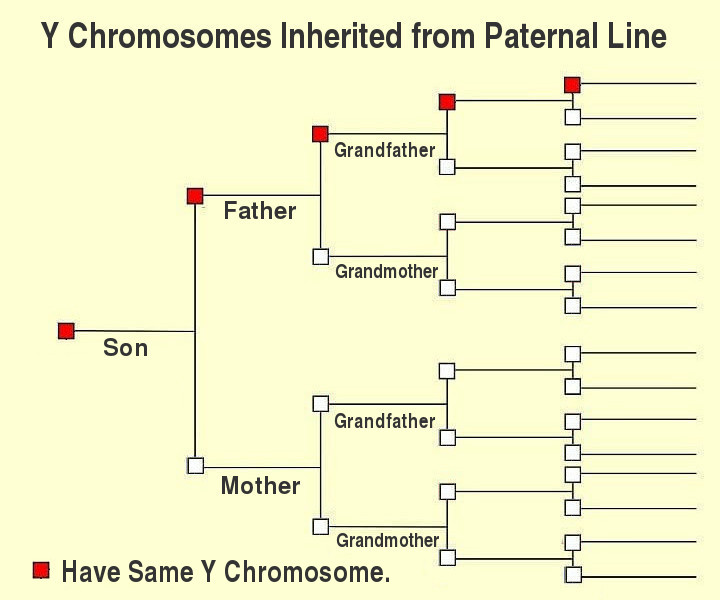 |
Combining that fact with the laws of tribal membership leads to a simple conclusion that all men who are prophesied to be of the seed (including the Y chromosome) of one of the twelve patriarchs of the tribes of Israel must be born of a line where all of the fathers were also of that tribe (see Figure 2). On the other hand, it is not the same for the X chromosome, because a woman inherits her two X chromosomes from both parents (click on Figure 2 to see X chromosome ancestors).
Now let us consider another way to join a tribe, besides a woman marrying into it. This method works for a man to be included in another tribe. It is as if that person is adopted into another tribe.
The typical case might be if a wife has a young child, a son or a daughter, and then her husband divorces her or dies. If she remarries a man from another tribe, knowing that her young children will grow up in that tribe, then her children can be adopted into the new tribe. That allows the children to grow up being a member of the tribe where they live. Even though the child, if a son, will lose his inheritance in the original tribe, he is eligible to gain his inheritance from his new step-father. In the case of woman being pregnant by one man and then marrying another, no adoption would be necessary because her child would be the legitimate and legal son of her husband.
A classic case of adoption in the House of Israel, occurred with Manasseh, the brother of Ephraim, being the only two sons of Joseph. Manasseh was adopted by his grandfather Jacob (Israel), which made him equal to the other brothers, including his biological father Joseph. Manasseh inherited land just like the other tribes of Israel. Manasseh and Joseph are each listed in the Bible as one of the twelve tribes from whom the 144,000 high priests will be chosen, 12,000 from each tribe (Rev. 9:4-8). The tribe of Joseph is sometimes called the tribe of Ephraim, because Joseph only had the two sons, so his only descendants who are in his tribe are those of his son Ephraim, the others all being in the tribe of Manasseh.
Thus, while it is understood that a man may only be a member of one tribe, he could be the offspring of a man from a different tribe. It is also important to understand that when one refers to the "house" of a man, such as the House of Israel, it definitely includes adopted children. That is a key point needed to understand many scriptures. It may even include servants, as when Abraham was given the law of circumcision, all of his male slaves were circumcised also (Gen. 17:10-13).
Now let us consider three classic cases of a promised descendant, each from a different tribe of Israel. One of these is the Savior Himself, while the other two have been compared to Him, being said to be "like unto" Him. The reason to consider these cases is that two of them are examples of lineages composed entirely of men. Thus, they support the proposal that the third example must also be composed only of men who compose the patriarchal lineage, which can be either biological or by adoption.
Let us begin by looking at the patriarchal lineage of Moses. In the same prophecy quoted above given to Joseph of Egypt, the Lord mentioned that Moses was prophesied by name to be raised up after him to lead the Israelites out of their captivity in Egypt:
And he shall be great like unto Moses, whom I have said I would raise up unto you, to deliver my people, O house of Israel. And Moses will I raise up, to deliver thy people out of the land of Egypt. — 2 Nephi 3:9-10
While it does not explicitly state that Moses would be raised up from the tribe of Levi, that turned out to be the case.
The main reason for including Moses at all in this article is that there is a very short patriarchal line between Levi, patriarch of the priestly tribe of Levi, and Moses: Moses was the son of Amram, who was the son of Kohath, who was the son of Levi (Num. 26:57-59).
While this short list of only four generations does not prove that the future prophet must be of the same tribe as he to whom the promise was made, let us now look at examples of two much longer lists of ancestors, which are both also composed entirely of men.
Now we come to Jesus Christ, who was prophesied to come as the Messiah even in the days of Adam. He is called a "prophet" in this section because Moses commanded his followers to heed a future prophet (Deut. 18:15), whom Peter identified as being Jesus Christ (Acts 3:22).
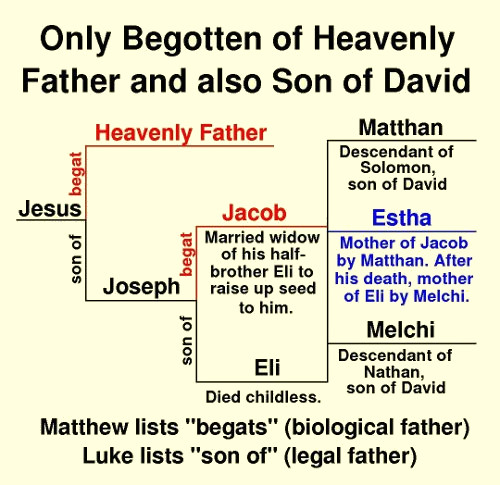 |
And I will put enmity between thee and the woman, and between thy seed and her seed; it shall bruise thy head, and thou shalt bruise his heel. — Gen. 3:15
That is significant because Jesus Christ was indeed born of woman, from the seed of the Virgin Mary. He was not, however, born from the seed of Adam but rather, He was the literal Son of God. In other words, as far as patrilineal descent is concerned, Mary's husband Joseph had a Y chromosome inherited through a line of fathers all the way back to Adam. Jesus Christ had a Y chromosome from Heavenly father.[1] Thus, Jesus could be called both (biologically) the "Son of God" and also (legally) the "son of David" as shown in Figure 3.[2] In fact, this may be the answer to the question posed by Jesus to silence his detractors, namely, how could the Messiah be both the son of David and also the Son of God (Luke 20:41-44).
On the other hand, the X chromosome of Jesus was inherited from Eve, so He was indeed the Seed of Woman!
Here we see that the principle of adoption applied even to the Savior. He was legally called the son of Joseph, which also made him the son of David. That is because his legal father Joseph was a patrilineal descendant ("son") of David both in a direct biological line as given in Luke 3, and also by adoption, as given in Matthew 1. It is often conjectured that one of those two different genealogies, which both claim to be of Joseph, must be of Mary, but that is not the case. As discussed above, the mother's genealogy is not important at all for determining tribal membership in Israel.
One final point concerning the suggestion of this article that all of these prophesied prophets discussed herein were patrilineal descendants of one of the patriarchs of the tribes of Israel, we see in the genealogies of Christ in both Matthew and Luke that all of the steps are men who are either the biological or legal sons of the man listed as their father.
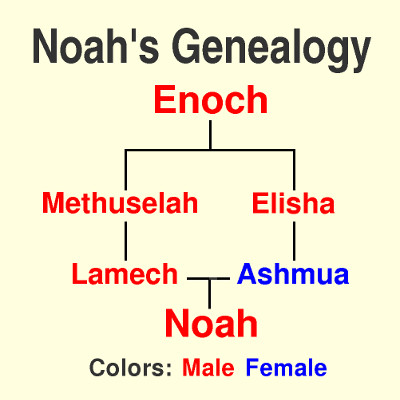 |
As part of the covenant that the Lord made with Enoch, it was promised that Noah would come from the fruit of his loins, which is another way of saying Noah would come from the seed of Enoch (Moses 8:2). Enoch's son Methuselah was also told the Savior would be his descendant, which caused him to brag that all of the kingdom's of the earth would descend from him (Moses 8:3). The reason that is interesting is that Methuselah married Ashmua,[3] the daughter of his brother Elisha. One might think that Elisha could also claim the same thing because Noah would also be his grandson (see Figure 4). But apparently the lineage of Noah's mother was not relevant to the promise that both Noah and the Savior would descend from Enoch. Thus, it appears that only the patrilineal ancestors were listed in the fulfilling of this promise, so Elisha was not included in that list.
Another interesting point is added by The Sealed Book.[4] It states that Noah blessed his son Shem that the Promised Descendant would come through him (Sealed Moses 6:11). Nimrod, grandson of Noah's son Ham, rebelled against that and claimed that he himself was the Promised Descendant, and convinced much of the world of his claim. He appears to be a type of the Antichrist who is soon to make his appearance.
Interestingly, this prophecy leads to another argument favoring that the promise to Enoch that Noah, and hence the Savior, would come from his seed, provides supporting evidence that it was implied that it would be patrilineal descent. If so, then Noah would descend through a line of all men so that Noah would inherit the same Y chromosome as had by both Enoch and Adam. Throughout this article, evidence is accruing that the "seed" of a man refers his literal offspring.
Now we turn to the prophecy of Joseph Smith by Joseph of Egypt to suggest that similarly, the Prophet Joseph Smith was most likely a patrilineal descendant of Joseph of Egypt.
Now let us consider the prophecy that Joseph Smith would be a descendant of Joseph of Egypt who would be a great seer.
After having looked at the genealogical patriarchal ancestral lines of both Moses and Jesus Christ, we understand better what it means to be of the seed of a man. So exactly what does the prophecy mean that Joseph Smith would be from the seed of Joseph of Egypt? First, let us look at that prophecy itself, in which Lehi quoted the words of Joseph of Egypt:
Yea, Joseph truly said: Thus saith the Lord unto me: A choice seer will I raise up out of the fruit of thy loins;... Yea, thus prophesied Joseph: I am sure of this thing, even as I am sure of the promise of Moses; for the Lord hath said unto me, I will preserve thy seed forever. — 2 Nephi 3:7,16
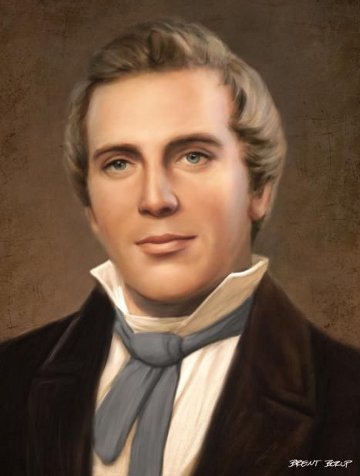 |
If this prophecy of the Prophet Joseph Smith follows the same pattern as that of Moses and Christ, then "seed" refers explicitly to the male descendants of Joseph of Egypt, in order also to have the prophet technically be of the tribe of Joseph. Today we know that means each father actually passes the same Y chromosome down the line. If so, that means on a pedigree chart like that in Figure 2 made for the Prophet Joseph as "son", that Joseph of Egypt would not just appear at some random location back some hundred generations or so, but he would appear on the very top line, which shows the patrilineal ancestors.
If true, this observation has profound significance for the prophecy given to Joseph of Egypt. Thus, it is here proposed that the promise to Joseph of Egypt that a great seer would be raised up from his seed means that he would be a patrilineal, biological descendant.
 |
For the mountains shall depart, and the hills be removed; but my kindness shall not depart from thee, neither shall the covenant of my peace be removed, saith the LORD that hath mercy on thee.
O thou afflicted, tossed with tempest, and not comforted, behold, I will lay thy stones with fair colors, and lay thy foundations with sapphires.
And I will make thy windows of agates, and thy gates of carbuncles, and all thy borders of pleasant stones.
And all thy children shall be taught of the LORD; and great shall be the peace of thy children.
In righteousness shalt thou be established: thou shalt be far from oppression; for thou shalt not fear: and from terror; for it shall not come near thee.
Behold, they shall surely gather together, but not by me: whosoever shall gather together against thee shall fall for thy sake.
Behold, I have created the smith that bloweth the coals in the fire, and that bringeth forth an instrument for his work; and I have created the waster to destroy.
No weapon that is formed against thee shall prosper; and every tongue that shall rise against thee in judgment thou shalt condemn. This is the heritage of the servants of the LORD, and their righteousness is of me, saith the LORD. — Isaiah 54:10-17 (emphasis added).
This prophecy clearly concerns our own era when soon the mountains shall flow down, when the city of Zion will be built with stones in its walls and gates, and when righteousness and peace shall be established, against which no weapon will prosper.
And how is this to be accomplished? The Lord will create a Smith who will blow the oxygen of life onto the glowing coals (the Bible?) to bring forth an instrument for his work (Book of Mormon as a sword of truth?). The point of quoting this scripture is that the surname is passed down to sons. Thus, if the proposal of this article is true and if there were no adoptions or surname changes, then if this prophecy was not fulfilled by Joseph Smith, it might be fulfilled by one of his descendants surnamed Smith.
Time will tell whether this prophecy of Isaiah refers to Joseph Smith himself, or of one of his future patrilineal descendants (D&C 86:10).
Now we are equipped to attempt to better understand a puzzling prophecy about a powerful millennial prophet. Isaiah prophesied that a shoot would grow out of the stump of Jesse (see Figure 7). That translation from the New International Version[5] is better than the King James version which states that a "rod" shall come forth from the "stem" of Jesse (Isa. 11:1). It goes on to predict that he will have the spirit of wisdom, be a righteous judge, and with his lips he will slay the wicked. He will definitely be a millennial prophet because the wolf, lamb, leopard, kid, lion, and calf will all lie down together in peace (Isa. 11:6).
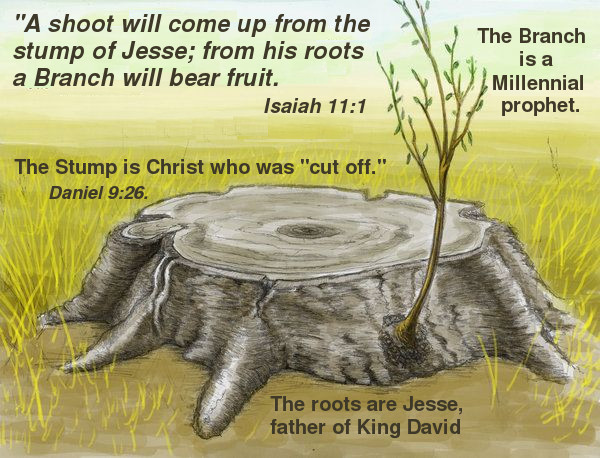 |
It also mentions that Ephraim would no longer envy Judah and Judah not vex Ephraim. Here it may be important to remember that these two names may not refer only to two tribes of Israel, but also may refer to when the twelve tribes split into two nations, where the northern kingdom was sometimes called Ephraim and the southern Judah. In any case, it appears that this great prophet who gathers all of the House of Israel is a peacemaker who may have connections to both of those tribes.
Great light was shed on just who this great prophet might be when the Prophet Joseph Smith inquired of the Lord as to just who this prophet might be. Consider the following answered he received:
Who is the Stem of Jesse spoken of in the 1st, 2d, 3d, 4th, and 5th verses of the 11th chapter of Isaiah?
Verily thus saith the Lord: It is Christ.
What is the rod spoken of in the first verse of the 11th chapter of Isaiah, that should come of the Stem of Jesse?
Behold, thus saith the Lord: It is a servant in the hands of Christ, who is partly a descendant of Jesse as well as of Ephraim, or of the house of Joseph, on whom there is laid much power.
What is the root of Jesse spoken of in the 10th verse of the 11th chapter?
Behold, thus saith the Lord, it is a descendant of Jesse, as well as of Joseph, unto whom rightly belongs the priesthood, and the keys of the kingdom, for an ensign, and for the gathering of my people in the last days. — D&C 113:1-6
Here we are told directly that the stump (or stem) of Jesse is Jesus Christ, as identified in Figure 7.
Then we are told this prophet is somehow from both Judah and Joseph, two separate tribes. This is obviously given to help narrow the number of candidates to fulfill this prophecy, but to me there has been one problem. Confusion results when one realizes that most people in the United States are descendants of both Judah and Ephraim, son of Joseph. For example, most descend from one of the European kings, many of whom made a point of being descendants of King David. Moreover, most have English ancestors, and England is mostly from Ephraim. So if so many are descendants of both Judah and Joseph, then what is the point of Isaiah's genealogical information?
Let's look at this part of the prophecy more closely, because we are told a great secret about the relationship of the this prophet, who is often called the Branch, to both Judah and Joseph. First, the Branch grows out the roots of Jesse, the father of King David. He does not grow as a descendant of Christ, but the Branch is a descendant of David's father growing from a root below the stump (Christ). From all we have seen in this article, that means the Branch descends from a patriarchal line back to Jesse.
We are also told that the Branch is also of the "house of Joseph" which includes those adopted into the tribe of Joseph, even though they may be biologically from a different tribe, such as Judah.
The point of this article is to propose that the Branch will descend biologically from a line of fathers back to Jesse, with one of them having been adopted into the tribe of Joseph.
This restriction narrows the number of candidates from potentially including millions to relatively very few. That is, the requirement for all male ancestors is much more difficult to fulfill, as shown in Figure 1. All of these results may be very important because the Branch will apparently also be an important priesthood leader (D&C 113:6).
A mysterious prophecy in Isaiah refers to a Branch growing out the root of Jesse who comes near the beginning of the Millennium, having much power. The Prophet Joseph Smith learned that he would come from seed of Jesse, but would also be of the House of Joseph.
This article attempts to understand that genealogy by discussing exactly what it might mean for a man to be of the seed of Jesse. This is done by considering three prophets which were to come from the seed of three different tribes of Israel. Moses would descend from the tribe of Levi, Jesus Christ would descend from Judah, through King David, and the Prophet Joseph Smith would be born from the seed of Joseph. In the first two cases where the genealogy is known, it was noted that the prophet was the patrilineal descendant of the tribal patriarch. It was suggested that the same was likely true of the Prophet Joseph.
It was also discussed that, even those the word "seed" was used to refer only to biological descendants, a man could be adopted into another tribe, in which case he was said to be of the "house" of, or even a "son" of, that tribe.
Finally, it was suggested that the Branch would be the patrilineal biological descendant of Jesse, but also be a patrilineal son of the House of Joseph by adoption. This information may prove useful in recognizing the fulfillment of this wonderful prophecy of God.